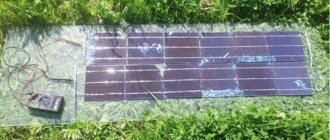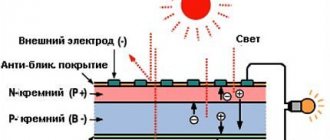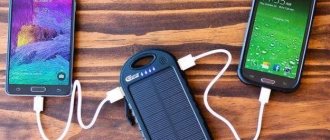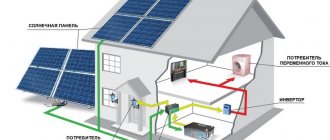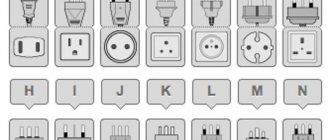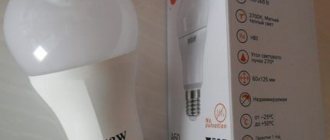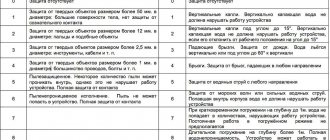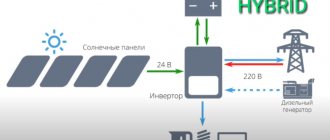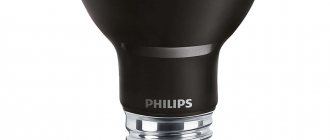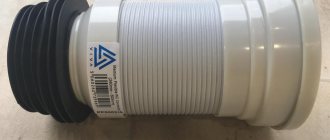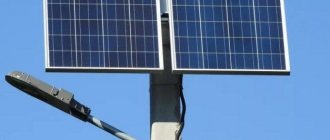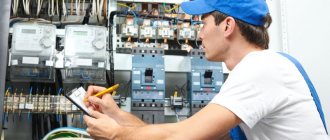An inverter is one of the integral components of any solar panel and wind generator system. Its task is to convert direct current generated by the panels into alternating current 220 volts, which is used by most modern household and industrial appliances.
But, despite the fact that all inverters perform the same function, not all of them may be suitable for your needs.
By what characteristics do they differ?
By type of application, inverters are divided into 3 types:
- network;
- autonomous;
- multifunctional.
Grid-tied solar inverters, also called synchronous inverters, work in conjunction with a centralized electricity supply system. They are designated “on grid”.
Their role is not limited to converting one energy into another, but also consists of adjusting network parameters, such as frequency, amplitude differences and others. The devices are able to turn off automatically in the event of failures occurring in the external circuit. They store energy in batteries.
The second ones, designated as “off grid”. With the 220 solar module, the inverter is connected as part of a separate system. They have no contact with the external electrical network, i.e. ensure the supply of electricity to the home, regardless of the operation of the centralized supply source. The power of such inverters lies in the range of 100-8000W.
AC voltage depends on the total power consumed by all electrical appliances that are simultaneously used in the house.
The inverter is selected taking into account direct current, based on the rated power of the solar panels. That is, if the power of all household devices turned on simultaneously is less than the capabilities of a particular power plant using solar energy, the excess can be sent to an external circuit.
If it is insufficient for all the necessary devices to work, external replenishment is provided. If the voltage in the house goes out, the battery comes into operation. The energy accumulated by the station enters the general network.
Network devices use solar energy more efficiently. They operate stably and always have a high efficiency value - up to 90%.
They are installed between the battery and the AC mains.
They are capable of functioning exclusively during daylight hours and are suitable for powering single devices connected to them.
What is a solar controller?
All types of solar power plants have a solar controller. Even in a grid-connected solar power plant it is present, it is simply part of the grid-connected inverter. And many hybrid inverters are produced with solar controllers on board. What is it and what is it for? I will talk about a hybrid and autonomous solar power plant, since this is exactly my case, and I can tell you more about the design of a network inverter in the comments if there are any requests in the comments.
A solar controller is a device that converts the energy received from solar panels into energy digested by an inverter. For example, solar panels are manufactured with a voltage that is a multiple of 12V. And batteries are manufactured in multiples of 12V, that’s just the way it is. Simple systems with 1-2 kW power operate on 12V. Productive systems of 2-3 kW already operate on 24V, and powerful systems of 4-5 kW or more operate on 48V. Now I will consider only “home” systems, because I know that there are inverters operating at voltages of several hundred volts, but this is already dangerous for the home.
So, let's say we have a 48V system and 36V solar panels (the panel is assembled in multiples of 3x12V). How to get the required 48V to operate the inverter? Of course, a 48V battery is connected to the inverter, and a solar controller is connected to these batteries on one side and solar panels on the other. Solar panels are assembled at a deliberately higher voltage in order to be able to charge the battery. The solar controller, receiving obviously higher voltage from the solar panels, transforms this voltage to the required value and transmits it to the battery. This is simplified. There are controllers that can reduce 150-200 V from solar panels to 12 V batteries, but very large currents flow here and the controller operates with worse efficiency. The ideal case is when the voltage from the solar panels is twice the voltage on the battery.
There are two types of solar controllers: PWM (PWM - Pulse Width Modulation) and MPPT (Maximum Power Point Tracking). The fundamental difference between them is that the PWM controller can only work with panel assemblies that do not exceed the battery voltage. MPPT - the controller can operate with a noticeable excess of voltage relative to the battery. In addition, MPPT controllers have noticeably higher efficiency, but are also more expensive.
Autonomous, requiring a battery
In this case, the inverter converts direct current from the batteries charging the solar panels. They are used for uninterrupted power supply, making users independent of not always stable energy supplies from centralized networks.
Hybrid inverters for solar panels, also multifunctional, are considered the most reliable.
They are a symbiosis of the two described devices. Their difference is the huge number of settings. They are the best option for setting up a home station powered by solar energy. At the same time, they are also the most expensive option.
Types differing in output voltage
Devices are divided according to this criterion into meander and sinusoidal. The voltage of the former at the output practically coincides with the power supply, which guarantees the safety of highly sensitive equipment
The output signal is a sine wave. For operating equipment, it is considered best if it is ideal. This is very important especially for telecommunication devices, high-frequency measuring instruments, and medical equipment. Even taking into account the high cost of these complex inverters, there are no other options for them. Therefore, such a serious parameter is indicated by manufacturers in the specifications.
For the second - non-sinusoidal inverters, the output pulse looks like a rectangle - a modified (quasi) sine.
Such inverters are not recommended for use where the load is single. But they are quite suitable for the active component of power.
Ideal sine wave inverters are large and expensive.
Quasi-sinusoidal ones, which produce a signal in a triangular shape, in the form of a trapezoid and a rectangle, are in greater demand, which is explained by their smaller size and cost.
Criteria taken into account when choosing
Along with the geometry of the output signal, it is also affected by its power.
Important: When choosing one of the main elements of batteries powered by solar energy, you need to proceed not only from the optimal geometry of the output signal: you must take into account the power. It is recommended to equip them with converters whose power value is higher than that of the equipment used by the consumer. The reserve must be at least 30 percent. It is also necessary to take into account the one-time load that occurs when several devices with high starting power are turned on simultaneously.
An important criterion is considered to be efficiency, which characterizes the associated energy losses. It varies for different devices and lies in the range of 85-95%. The optimal value is considered to be 90%.
Examples of models from different manufacturers
The following is a list of several companies that supply inverters for solar panels to the Russian market.
- TBS Electronics. This Dutch manufacturer produces exclusively sine wave inverters under the Poversine brand. The company's product line includes low-power converters (175-600 watts). Their price ranges from 10 to 25 thousand rubles. There is a group of more powerful ones (850-3500 watts), the price of which is 35-80 thousand rubles;
- This Chinese manufacturer produces a wide range of inverters. Among their features is the ability to monitor the operation of the GoodWE converter using a smartphone or tablet PC. To do this, you only need to install a special program in the Android OS. Like all Chinese manufacturers, GoodWE offers attractive prices. For example, 20 kW inverter models cost about 5 thousand “evergreen”;
- Schneider Electric. The company produces models of inverters for solar panels under the Conext brand. According to the manufacturer, their models not only convert current, but also increase the efficiency of solar panels operating on the roofs and facades of buildings. Conext converters are approximately 97 to 98 percent efficient. Prices for Schneider Electric products range from 90 to 330 thousand rubles;
- MAP "Energy". A domestic manufacturer produces current converters for solar panels with a capacity of 800-1200 kW. The prices here are also quite high. Thus, the SIN MAC model with a pure sinusoidal output signal costs from 25 to 135 thousand rubles, HYBRID MAC from 30 to 170. Three-phase devices are also produced. For example, MAP HYBRID. MAP Energia products are equipped with high-power chargers for charging batteries.
Single-phase and three-phase inverters
The former are characterized by low cost. The choice will be justified if the power consumption does not exceed 10 kW. Their frequency is 50 Hz and the voltage is 220V.
For the latter, the voltage range is much wider - 315 Volts, 400 and 690.
High-quality equipment is necessarily equipped with transformers installed at the entrance. It is not difficult to determine whether a transformer is included in the circuit. Since there is a relationship between the weight of the inverter and the technical parameters, i.e. if there is 100 watts of power per kilogram of weight, then the transformer is installed.
The system may have a different number of inverters. One is installed on low-power systems, i.e. up to 5 kW. If the power is greater, then two or more inverters may be required. It’s good when there is an inverter for every 5 kW.
For some models, the developer provides charging, which is responsible for the operation of the entire system, even if one of the inverters fails.
Video: Inverter for solar battery pure sine
Design and principle of operation
Inverters for solar stations are technical devices used to convert electricity stored in batteries into alternating current, the parameters of which correspond to the parameters of the devices connected to the batteries. The power plant consists of panels, a controller, a battery and an inverter.
The inverter itself structurally consists of:
- adapter;
- varicap;
- dinistors;
- transformer (optional);
- fan;
- linings.
Some models are equipped with uninterruptible power supply units. The task of an uninterruptible power supply is to monitor the voltage level using a microcontroller. If for some reason the supply of main electricity stops, it gives the command to connect backup power sources.
The operation of a solar station involves connecting a certain number of household appliances and electrical equipment, the operation of which requires alternating current with a voltage of 220-380 V. The sun's rays, falling on the surface of the panels, are converted into electric current. Then it goes to the controller, where it is charged with the correct current and voltage, then goes to the battery, accumulates and is stored. From there it enters the inverter, is converted into alternating current and is used for household needs.
Emergency situations occur at power plants, which leads to a lack of DC supply. Once you detect the installation of solar panels, you won’t have to worry about being left without light, because... They will not stop the supply of electricity to the battery.
Several single-phase inverters can be combined into several three-phase 380 V installations. At the same time, they will also increase their power and expand their capabilities.
What does a solar inverter look like?
Like any solar station equipment there are pros and cons. Small devices can be placed in places where there is no centralized electricity or taken with you on hikes to charge phones and other equipment. In addition, the current obtained from such batteries is absolutely free, even if they work in parallel with general electricity.
The disadvantage of photovoltaic power plants is their high cost, and they will pay off only after 10 years. To install a large number of panels, you will have to sacrifice the design of the roof or wall, because... they take up a lot of space. If electricity comes only from a solar power plant, you will have to put up with its inconsistency. The power of the device depends on the weather, and in the winter it is often cloudy.
Connection
There are some nuances here, so you need to be careful, since the functioning of the system as a whole depends on the correct connection.
Basic moments:
- The length of the DC cable should be as short as possible, but the maximum cross-section should be selected.
- If the solar cell and the consumer are significantly removed, it is worth lengthening the cable through which the alternating current is transported:
- The length of the wire between the inverter and solar panels should not be more than 3 meters. If possible, then it is better to place them nearby. The conditions must be met very strictly, primarily for powerful inverters (more than 0.5 kW);
- Wire connections also require attention, since if they are made with insufficient density, they can lead to a fire. And we also need automatic switches to ensure an uninterrupted supply of electricity to the facility.
The most correct solution is a hybrid type piping for connecting inverters (for both AC and DC).
The principle is based on a special order of connecting the converters. Their controllers turn on when the batteries run out. This works especially effectively in places where there are more cloudy days throughout the year and where electricity is often cut off.
How to choose solar panels?
At first glance, all solar panels are the same: the cells of solar cells are interconnected by busbars, and on the back side there are two wires: plus and minus. But there are a lot of nuances in this matter. Solar panels come from different elements: amorphous, polycrystalline, monocrystalline. I will not advocate for one type of element or another. Let me just say that I myself prefer monocrystalline solar panels. But that's not all. Each solar battery is a four-layer cake: glass, transparent EVA film, solar cell, sealing film. And here every stage is extremely important. Not just any glass is suitable, but with a special texture, which reduces the reflection of light and refracts light incident at an angle so that the elements are illuminated as much as possible, because the amount of energy generated depends on the amount of light. The transparency of the EVA film determines how much energy reaches the element and how much energy the panel generates. If the film turns out to be defective and becomes cloudy over time, then production will drop noticeably.
Next come the elements themselves, and they are distributed by type, depending on quality: Grade A, B, C, D and so on. Of course, it is better to have quality A elements and good soldering, because with poor contact, the element will heat up and fail faster. Well, the finishing film should also be of high quality and provide good sealing. If the panels become depressurized, moisture will quickly enter the elements, corrosion will begin, and the panel will also fail.
How to choose the right solar panel? The main manufacturer for our country is China, although there are also Russian manufacturers on the market. There are a lot of OEM factories that will paste any ordered nameplate and send the panels to the customer. And there are factories that provide a full production cycle and are able to control product quality at all stages of production. How can you find out about such factories and brands? There are a couple of reputable laboratories that conduct independent tests of solar panels and openly publish the results of these tests. Before purchasing, you can enter the name and model of the solar panel and find out how well the solar panel matches the stated characteristics. The first laboratory is the California Energy Commission, and the second European laboratory is TUV. If the panel manufacturer is not on these lists, then you should think about quality. This doesn't mean the panel is bad. It’s just that the brand may be OEM, and the manufacturing plant also produces other panels. In any case, the presence in the lists of these laboratories already indicates that you are not buying solar panels from a fly-by-night manufacturer.
What is included?
The solar installation is formed by:
- solar panel with battery;
- inverter;
- controller.
Inverters are needed to convert direct current into alternating current, since household appliances cannot directly use the energy accumulated by solar panels.
Calculation of the minimum number of modules in the circuit, taking into account the permissible starting voltage of the inverter
Each inverter has a minimum input voltage, in our case it is 200 V.
Minimum input voltage of the Fronius SYMO inverter 10 kW
In turn, the modules reach their minimum operating voltage at a temperature limit of 70°C. Therefore, the minimum number of panels in a string is calculated for this temperature, rounding up the value. In this case, the formulas are used:
Where:
- Uoc (Tmax) - voltage at maximum temperature 70 ° C;
- Uoc - open circuit voltage (38.5 V);
- Tmax - maximum operating temperature (70 ° C);
- βT—temperature coefficient of the module (-0.31%/K);
- Nmin — minimum number of solar panels;
- Udcstart — Applied starting voltage (200 V).
Uoc (Tmax) = 38.5 (1 + (70 - 25) (-0.31 / 100)) = 33.13
Nmin ≥ 200 / 33.13 = 6.04
We take the nearest integer value upward, so it is recommended to install at least 7 modules sequentially in one string.
Choice
Basic selection options:
- peak, rated and load power;
- efficiency;
- weight of the device;
- temperature regime.
- In addition, you should ask whether there is protection against:
- possible overloads and overheating;
- from short circuit;
- voltage supplied from batteries (low and high).
Important: technically, it is easy to evaluate the performance of an inverter, knowing its weight, if you know that per 100 watts of output power there is a kilogram of device mass.
Solar Inverter Selection Parameters
The efficiency of the converter and the entire power supply system largely depends on the correct choice of equipment parameters.
In addition to the characteristics described above, you should evaluate:
- output power;
- type of protection;
- operating temperature;
- installation dimensions;
- efficiency;
- availability of additional functions.
Let us next consider all these characteristics in more detail.
Criterion #1 - device power
The rating of the solar inverter is selected based on the maximum load on the network and the expected battery life. In start-up mode, the converter is capable of delivering a short-term increase in power at the time of commissioning capacitive loads.
This period is typical when turning on dishwashers, washing machines or refrigerators.
When using lighting lamps and a TV, a low-power inverter of 500-1000 W is suitable. As a rule, it is necessary to calculate the total power of the equipment being used. The required value is indicated directly on the device body or in the accompanying document.
It is advisable to increase the resulting value by 20-30% - this will be the required output power of the inverter. For example, the total power of the equipment is 500 W/h, the battery life is 5 hours. Calculation: 500 W/h*5h*1.2=3000 W/h
Criterion #2 - level of protection
A high-quality solar inverter should have several stages of protection. Possible options: forced cooling system, short circuit prevention, protection against voltage dips and surges in the network.
It is also important to have a sealed, reinforced housing that prevents dust and moisture particles from getting inside. The protection indicator of electrical equipment is standardized according to the IEC-952 standardization.
The index is designated as IP AB, where A is the level of protection against the penetration of foreign particles into the device, B is resistance to moisture.
For outdoor operating conditions, models with the index “IP65” are suitable - the strength and reliability of the inverter allows its use in the external atmosphere.
Criterion #3 - operating temperature and dimensions
A wide range of values is an indicator of decent build quality of the inverter. The value of the indicator is especially relevant when placing the converter in an unheated room.
Weight is an indirect indicator of the quality of the inverter. There is an opinion - the heavier the converter, the more powerful it is. This is explained by the presence of a transformer in high-power equipment.
According to observations, one kilogram of solar inverter weight corresponds to an output power of 100 W. The dimensions of the inverter determine the method of its installation
Criterion #4 - efficiency
Experts recommend purchasing current “converters” with an efficiency of 90% or more. Only with this parameter will the operation of the solar system be effective and its arrangement expedient. Losing 10% of solar energy is an unacceptable luxury.
Additional functionality. Advanced capabilities affect the cost of equipment and are not always in demand. However, some options are worth the money spent.
Useful and necessary “devices” include:
- automatic addition of inverter power to the grid electricity;
- adjusting the battery charging period;
- selection of priority current source;
- maintaining work with different types of batteries (alkaline, lithium iron phosphate, helium, AGM, acid);
- possibility of combined operation with a network converter;
- setting the voltage indicator - preventing “jumps” in the mains voltage;
- possibility of upgrading the inverter by updating the firmware.
Modern converters can be connected to a PC for programming and monitoring.
Manufacturers offer free software to monitor the operation of company equipment and electrical networks. An interesting option is the ability to send SMS notifications about the system status upon user request
What is the difference between stand-alone and network inverters?
The first ones do not need additional batteries, but they only work with devices that control the power of solar structures. Such solutions give them the ability to automatically turn on when there is enough battery power to generate alternating current. They are equipped with classic sockets necessary for connecting devices to the network.
We recommend:
- Goal Zero Nomad 13: what devices it charges, features and where it’s profitable to buy
- Advantages, disadvantages and prospects of amorphous solar cells
- Types of solar panels, production features, differences
The latter need equipment that allows them to recharge batteries. In addition, they have components that prevent you from making a mistake with the polarity, leaving the battery not fully charged, or allowing it to be overcharged.
There are a lot of models. They are produced by manufacturers in different countries. Among those supplied to the Russian market, the following can be distinguished.
Domestic
The widest range of converters is created by MAP "Energy" (from 800 to 1200 W).
The Russian company produces several lines of these devices:
- sinusoidal with an output signal in the form of a pure sine wave - MAP SIN. Their price is 22,800-130,500 rubles;
- sinusoidal with additional energy taken from batteries - MAP HYBRID, costing from 29,700 to 166,500 rubles;
- 3-phase - HYBRID MAC, suitable for charging all types of batteries using high-power charging.
Inverters of this brand are designed for private households and industrial facilities, and are used quite actively in the construction industry, medicine, and at meteorological stations.
A huge achievement is the inverter with a record power of 20 kW, which can withstand a huge load of 25 kW. It is capable of providing electricity to a multi-story building with a large number of equipment.
Solar Photovoltaic Converters
Maxwell was the first to point out the connection between electricity and light. This connection was later proven by Moscow State University professor A.G. Stoletov, in whose experimental setup (1888) an electric current generated by light rays flowed. In 1954, Pearson, Chapman and Fuller illuminated two different silicon wafers sandwiched together like a sandwich. An electrical circuit was formed in which a current arose as a result of the internal photoelectric effect.
The direct conversion of solar radiation into electricity is carried out by semiconductor photovoltaic converters (PVCs). Russian scientists are recognized leaders in the field of designing materials for semiconductor elements. Researchers led by Nobel laureate Academician Zh. Alferov managed to create completely new structures of semiconductor materials for solar cells.
Currently, the most widely used solar cells are based on silicon doped with elements of groups III and V to produce the so-called p–n junction. FECs made of monocrystalline, polycrystalline and amorphous silicon are used. The basis of PV cells are solar cells having the shape of a circle with a diameter of up to 100 mm or a polyhedron. The elements are assembled into modules that have a power of up to 100 W under standard insolation (Figure 2). Batteries in some cases with a power of up to several MW are assembled from such modules.
The advantage of FEP is that it uses both direct and diffuse radiation, does not require tracking of the Sun and requires virtually no maintenance. The best mass-produced monocrystalline silicon modules have an efficiency of about 18% and cost 3.5–4 $/W.
According to the IEA, in 20 industrialized countries, the total installed capacity of solar power plants by the end of 2003 amounted to 1.8 GW, and in 2003 alone it increased by 0.43 GW.
In 2005, the world produced PV cells with a total capacity of 1.727 GW, and by the end of 2010, production is expected to increase by 3.5 times.
Despite the high rate of increase in installed PV capacity in both developed and developing countries, due to the high cost of materials and manufacturing technology, the cost of electricity from PV is still high - in favorable conditions, about 0.20 cents/(kW h) .
Some prospects for reducing the cost of electricity are associated with the operation of solar cells using concentrated solar radiation. This reduces the specific cost of the solar cell itself, but adds the cost of the concentrating device. In this case, it turns out to be advisable to use more expensive materials and structures that provide higher efficiency instead of silicon. However, such systems have not yet found widespread use.
In southeastern Spain, in Caravaca de la Cruz, work is underway to create a 5-megawatt solar power plant (Figure 3). The new solar enterprise will unite 500 installations of 10 kW each, with a total surface of solar panels of about 350 thousand m2. Thanks to the use of a biaxial solar tracking system, individual photovoltaic systems will be constantly facing the sun, which will allow maximum use of its energy from dawn to dusk. According to preliminary calculations, the use of a tracking system in comparison with fixed modules will increase electricity generation by 40–45%. This will increase electricity production by approximately 2000 kW h/year from each kilowatt of installed SES capacity, which will give an annual increase in electricity generation of up to 10 GW h.
Figure 3. — PV batteries
The new PV facility comes amid Spain's renewable energy plan, in which the government has set a target of installing 400 MW of solar PV systems by 2010.
In Germany, near the city of Prenzlau, the largest plant ever created for the production of solar panels has been put into operation. It was built near the already existing similar enterprise Aleo/SMO. Its production capacity is 90 MW, which corresponds to approximately 550 thousand modules per year. This number of annually produced solar cells will provide electricity to about 45 thousand people.
The creation of the company was a response not only to the rapid growth of the domestic market for photovoltaic technologies in Germany, but also to the rapid growth of the global market for these technologies.
Today in Russia there is a sufficient scientific basis for the development of photoenergy and powerful production that is capable of creating any modern solar photovoltaic installations.
The economic potential of solar energy in Russia is relatively small, which means that the construction of a solar power plant with a thermodynamic cycle is hardly advisable. At the same time, conditions for the creation of solar water heating installations (SWH) for hot water supply exist almost everywhere, especially in the warm half of the year. Solar heating using coolant heating systems in the UK is not economically feasible for Russia. The low flux density of solar radiation entering during the cold season would require prohibitively large sizes of solar cells per unit of heated area. However, the passive use of solar heat through intelligent building architecture is of interest.
Along with VCA, it is advisable to use solar energy to produce electricity using solar cells in low-power installations (in communication systems, alarms, navigation, for domestic needs in hard-to-reach areas, etc.).
Of particular interest are autonomous low-power power supply systems (up to 6 kW), which can be used in small enterprises, farms, and individual residential buildings using solar and wind energy (Figure 4).
The disadvantage of such a power supply is the inconsistency in the amount and time of supply of electricity from the source to the consumer. So, in the absence of the Sun, the solar battery stops working and the consumer is de-energized. The same thing happens with a wind power plant if the wind speed is below 3 m/s.
By adding a battery to the power supply system, you can get rid of these disadvantages. Excess electricity generated by various sources can be stored in a rechargeable battery (AB). The inverter converts 24 V DC voltage into 220 V AC voltage. Electricity consumers are connected to the inverter output.
In conclusion, we note that the high cost of electricity from PV cells hinders their wider use. This high cost is due to the high cost of high purity silicon and the manufacturing process. Intensive research and development is underway around the world and in Russia aimed at reducing the cost of solar cells.
Photoelectric converters
Photovoltaic converters (PV) are becoming increasingly used in different countries. More than 90% of the market is solar cells based on poly- and monocrystalline silicon, the modules of which have an efficiency of 15–17%. In mid-latitude conditions, such photovoltaic installations can produce 120–200 kWh/m2 per year. Many research centers are conducting work aimed at increasing the efficiency of solar cells by creating layered (cascade) structures that provide a more complete conversion of solar radiation energy across its entire spectrum, as well as reducing the cost of semiconductor materials and solar cells in general through the use of thin-film structures and use of solar radiation concentrators. It is expected that in the foreseeable future the efficiency of industrial solar cells can be increased to 30–35%. Although intensive research and development in the field of photovoltaics in all leading countries of the world has led to serious successes both in terms of increasing the efficiency of photovoltaic converters and in terms of reducing the cost of their production, the cost of electricity obtained from solar cells is still much higher than the cost of electricity generated by traditional sources energy. Currently, electricity received from solar power plants should be considered as an opportunity to supply energy to consumers who are remote from the power grid or who want to have a backup source in case of failure of the power supply system. Most often, we are talking about installations of relatively low power, which include a rechargeable battery for power supply at night.
Applications of photoelectric converters
Autonomous power supply for consumers not connected to a centralized power supply
Communication systems (repeaters, mobile radio systems, telephone networks, autonomous monitoring and control systems). The power of photovoltaic installations used in this area ranges from several watts to several kilowatts.
Cathodic protection . PV cells are widely used as an autonomous power source for corrosion protection systems of telecommunication towers, pipelines, underground metal tanks and underground building structures exposed to aggressive environmental influences. As a rule, their power for these purposes does not exceed 10 kW.
Signaling devices . Power supply using FEP for signal navigation lights on rivers, at sea, safety lights installed on power lines, high-rise buildings, light and sound signaling devices on railways and roads, etc.
Lighting . Tens of thousands of solar cells in combination with rechargeable batteries are used in different countries to illuminate billboards, road and parking signs and signs, etc., including inside large cities.
Electric refrigerators . Electric refrigerators powered by solar cells have become widespread, especially in countries with hot climates, making it possible to store valuable perishable products, primarily medicines, vaccines, etc.
Remote monitoring . This direction of using FEP is also one of the most common. Today, there are more than 100,000 photovoltaic installations in different countries that provide power to autonomous weather stations, stations for autonomous control of temperature and water level, fluid flow in pipelines, control of air pollution levels near industrial enterprises, etc.
Water pumping installations . Photovoltaic installations are used for lifting drinking water from wells and wells, for irrigation purposes in agriculture. The units operate in the presence of solar radiation, accumulating water in a tank. Such installations are characterized by a simple design and are relatively inexpensive, since they do not require the use of rechargeable batteries.
Energy supply for residential buildings
One of the challenges associated with the use of PV in residential and administrative buildings is that PV modules can replace traditional building elements and cladding materials. At the same time, they must satisfy architectural solutions and be attractive from an aesthetic point of view.
Creation of solar power plants
In a number of countries, there are several dozen demonstration photovoltaic stations with a capacity of more than 100 kW each, which are prototypes of future large solar power plants. They are still far from self-sufficiency, but are important for accumulating operating experience and demonstrating promising environmentally friendly energy technologies. In Russia, the total production capacity for the production of PV cells, according to manufacturers, amounts to several MW per year. PV cells produced by several Russian enterprises meet modern international standards and are mainly supplied to foreign countries.
Rice. 7.1. Block diagrams of power supply systems with solar panels: SB – solar battery; K – controller; AB – rechargeable battery; I – inverter; RU – switchgear; N – load
There are three main structural and circuit solutions for power supply systems using solar power plants. Their varieties are presented in Fig. 7.1.
- An autonomous photovoltaic power plant is completely independent of external power supply networks (Fig. 7.1, a). All autonomous systems must include an energy storage device or battery. Energy from batteries is used during times of insufficient solar radiation or in cases where the load exceeds the generation of solar panels.
- Photovoltaic power plant operating in parallel with an external network (Fig. 7.1, b). Excess power generated by solar panels can be sent to the grid. If consumption exceeds the generation of electricity by solar panels, then the missing energy is taken from the grid. For this purpose, DC-AC voltage converters are used - inverters, which can operate in parallel with the network.
- A system with a battery-free connection to the network is the simplest of all systems (Fig. 7.1, c). It consists of solar panels as well as an inverter connected to the grid. All generated electricity is supplied to the network. There are no batteries in such a system, so they cannot be used as backup systems. When the grid goes down, the generation of electricity from solar panels also stops. This may be a limitation of such a system, but its main advantage is low price and high reliability.
The efficiency of a photovoltaic system depends on the level of solar radiation. The main component of photovoltaic systems are modules into which photocells are combined. Modules can be designed for any voltage, up to several hundred volts. If the system has AC loads, then inverters are included in the system to convert to AC. When choosing photocells for an autonomous solar power system, you need to know the efficiency of a particular type of photocell. It is known that the efficiency of a photocell is the ratio of the energy entering the photocell to the electricity supplied to electricity consumers. There is a practical value of efficiency, theoretical and laboratory values of efficiency. Below are the practical efficiency values of commercially produced photovoltaic cells:
- monocrystalline silicon solar cells: 16–17%;
- polycrystalline silicon solar cells: 14–15%;
- amorphous silicon solar cells: 8–9%.
Foreign
The most famous are converters developed in France by Schneider Electric, which are famous for their performance parameters that make them suitable for use in areas with different climates. Their body is protected from corrosion by a special coating.
Conext from Schneider Electric
They were developed to improve the efficiency of batteries installed on the roofs of buildings. They can be used even in the most difficult climatic conditions. Efficiency reaches 97.5%, power is in a wide range - 3-20 kW.
The price range is 86900-327300 rubles.
Purpose
It is designed for installation on the roofs of high-rise buildings and country cottages.
Reliability
During manufacturing, inverters undergo strict quality control using various techniques and tests.
Design
It does not contain electromechanical capacitors, which dramatically increases the reliability of the devices and increases their service life. Even with maximum load, the device achieves an efficiency of 97.5 percent. Some models do not have a distribution block, therefore, installation of an electrical panel is not required.
From a huge range of devices with a power of 3-20 kW, everyone will choose the most suitable model.
Review of popular hybrid converters
Among consumers, inverters from foreign companies received good reviews: Xtender (Switzerland), Prosolar (China), Victor Energy (Holland), SMA (Germany) and Xantrex (Canada). Domestic representative - MAP Sine.
Xtender range of multifunctional inverters
The Studer hybrid converter from Xtender is the embodiment of the Swiss quality standard in power electronics. The Xtender series solar inverters are distinguished by their impressive strength characteristics and extensive functionality.
Variety of models: XTS - low-power representatives, XTM - medium-power models, XTN - high-power inverters.
Xtender power ranges: XTS - 0.9-1.4 kW, XTM - 1.5-4 kW, XTN - 3-8 kW. Output voltage – 230 W, frequency – 50 Hz
Each Xtender Hybrid Series offers the following features and options:
- pure sine wave feed;
- “addition” of power to the network from the battery;
- when the mains voltage decreases, consumption from the central power supply is reduced;
- two priority selection modes: the first is “soft” with power supply within 10%, the second is a complete switch to the battery;
- variety of installer settings;
- management of the backup generator;
- standby mode with a wide control range;
- remote monitoring of system parameters.
All modifications have the Smart Boost function - connection to different power suppliers (generator set, network inverter) and Power Shaving - guaranteed coverage of peak loads.
Optimal Prosolar Hybrid converters
The Chinese-made model has good characteristics and an acceptable cost (about 1200 USD). The converter optimizes the operation of solar panels by storing unused energy in the battery.
Technical characteristics: voltage form - sinusoid, conversion efficiency - 90%, installation weight - 15.5 kg, permissible humidity - 90% without condensation, temperature -25 ° C - +60 ° C
Distinctive features:
- option to track the limiting power point of a solar battery;
- information LCD display displaying operating parameters of the system;
- 3-level battery charger;
- maximum current adjustment up to 25A;
- inverter communication.
The converter is connected to a PC via software (supplied as a kit). It is possible to modernize the inverter through innovative flashing.
Sine wave inverters Phoenix Inverter
Phoenix inverters meet high demands and are suitable for industrial applications. The Phoenix Inverter series is released without a built-in charger.
The converters are equipped with the VE.Bus information bus and allow operation in parallel or three-phase configurations.
The power range of the model range is 1.2-5 kW, efficiency is 95%, voltage type is sinusoid.
The table shows the characteristics of the hybrid modification of the 48/5000 inverter from Victron Energy. The estimated cost of a Phoenix Inverter with a power of 5 kW is 2500 USD.
Competitive advantages:
- “SinusMax” technology supports the launch of “heavy loads”;
- two energy saving modes – load search option and no-load current reduction;
- presence of an alarm relay - notification of overheating, insufficient battery voltage, etc.;
- setting programmable parameters via PC.
To achieve high power, up to six converters can be connected in parallel to a phase. For example, a combination of six devices with a rating of 48/5000 is capable of providing an output power of 48 kW/30 kVA.
Domestic MAP devices Hybrid and Dominator
has developed two modifications of the hybrid converter: Gibrid and Dominator.
The power range of the equipment is 1.3-20 kW, the time period for switching between modes is up to 4 ms, the possibility of “pumping” electricity into the city network is provided.
Comparative table of converter capabilities. Both types are capable of working in ECO mode; each model “connects” with a Web server for remote monitoring and adjustment
General characteristics of the Hybrid and Dominator voltage converters:
- transformer based on a torus;
- There is no input voltage stabilization;
- power “pumping” mode;
- output is pure sine;
- generation of excess energy into the network;
- limitation of current consumption at the AC input;
- class IP21;
- consumption in “sleep” mode is 2-5W.
The efficiency of the converters reaches 93-96%. The devices have successfully passed tests for use at ultra-low temperatures (limit value -25°, short-term reduction to -50 °C is acceptable).
Dutch
Another well-known company from Holland, TBS Electronics, has been known on the market for more than 24 years. Its line of business is the production of low- and medium-power converters that have a sinusoidal output. They are designed to operate with solar panels whose power ranges from 175 to 3500 W.
You can buy such inverters for solar panels for 9,400 to 79,800 rubles.
Powersine PS3500-24
A professional device provides power to heating boilers, personal computers, pumping equipment and other low-load devices. It is equipped with reliable electronics, the metal case is highly durable.
As with the previously described device, the Powersine line is characterized by a pure output sine wave, which is guaranteed to ensure a long service life and high reliability of high-sensitivity devices.
Another advantage is the short circuit protection that the developer has equipped it with, against occasional overloads and temperature surges.
The inverter is suitable for starting loads up to 500 V, with a starting power several times higher than the rated one.
High-frequency innovative inverters produced by Kostal are available in single-phase and three-phase. Their power range is 1.5 -20 kW.
Even in the basic configuration they are equipped with:
- automatic AC switches;
- monitors;
- MPP trackers;
- SO counters.
This makes it possible to use them in a “smart home”. They are easy to install and operate. The built-in information panel helps to monitor their work. Modern high-quality materials were used for the housing, so in addition to internal installation, they allow external installation.
You can purchase it on the website https://tbs-electronics.nl/product/powersine-inverters-2000w-3500w-12v24v48v/.
TOP 6 inverters 2022 – budget class
The second six of our rating differs from the first mainly in the level of functionality and power. The reliability of budget-class equipment is almost identical to the “elite” one, but you can buy such inverters much cheaper.
Bineos
The rating of inverters for home is headed by one of the best Chinese brands in the field of inverters. Despite the Taiwanese registration, factories for the production of Bineos inverters are located in mainland China, Shenzhen province. At a relatively low cost, all brand products are distinguished by impeccable quality and functionality. And these are definitely one of the best inverters for the home. The number of innovations used in Bineos inverters is evidenced by the fact that only research development in the company is carried out by a separate division with a staff of over 200 people.
Even the most budget models, for example, the Bineos EM3KF inverter, are distinguished by:
- ideal outgoing sine wave;
- high efficiency of current conversion;
- wide range of settings;
- information content;
- compactness and stylish design.
SmartWatt
Russian “inverter” brand owned by Delta Solar. The main buyers, in addition to the domestic market, are the Russian Federation and neighboring countries. It is distinguished by a huge variety of inverters offered for a wide variety of tasks and a wide range of prices from 20 to 370 thousand rubles.
Experts and buyers note the high quality of models of all three offered series:
- ECO – for hybrid systems and backup systems, power from 1 to 7.2 kW. They have a built-in controller for solar panels. Be sure to connect to the battery.
- Hybrid - multifunctional equipment with a built-in controller for operating in hybrid mode with the ability to use the main source of energy of any type. There are models that can work without a battery.
- GRID is a group of powerful network inverters up to 60 kW, the best-selling of which is SmartWatt Grid 5K 1P 2MPPT.
Solax Power
Solax Power is another “newcomer” among inverters in the home rating, which quickly gained popularity. Perhaps the high demand was influenced by the fact that the brand belongs as a “daughter” to one of the giants of the Chinese solar market, the Suntellite Group concern.
Traditionally for China, Solax Power won third place in the ranking by cost. The price of all inverters in the Solax Power X line is almost 2 times lower than “European” ones of similar quality and capabilities.
GoodWe
The fourth place in the rating of inverters for the home is occupied by another “Chinese” GoodWe, whose models captivate with their stylishness and fantastically reliable performance. This is the only inexpensive brand in the Middle Kingdom that has not received a single objective claim regarding quality over the past 10 years.
Among the Good Wee inverters, the most successful and popular is the 2022 Goodwe DNS - without any special functional frills, but very reliable, compact and cheap.
Delta
Delta Group's fifth place is due to its not-so-successful initial entry into the market. The first series of "Delta", RPI inverters, turned out to be extremely unsuccessful. The brand's popularity began to grow only in 2022, after the release of the updated Delta Home Series line. What prevents Delta Group’s equipment from rising higher in the list is its relatively high price for China – even Huawei’s is lower. However, a big plus is the 5-year warranty, which is not typical for state employees.
Ingeteam
The only European on the list is the Spanish Ingeteam, despite its excellent characteristics, losing out to the Chinese in the “budget” sector due to its higher price. All models of the brand are distinguished by the quality, versatility and information content of monitoring characteristic of Europe.
The TOP popularity falls on the 1Play TL-M series, which includes a line of models with a power range of 2.5 - 6 kilowatts.
Which inverter is best to buy for your home is up to you to decide. If you have any doubts when choosing an inverter, our specialists will give their professional advice and select the most profitable inverter option for a solar station for your home, cottage or business.
Inverters in Taiwan
Equally high-quality inverters produced in Taiwan.
They are represented on the Russian market by:
- stand-alone SLP and SL converters;
- hybrid offline-network HTP;
- hybrid HT.
The first are equipped with charge controllers powered by solar energy. In addition to the main purpose - an inverter, they can be used as controllers and chargers. The main parameters are displayed on a digital monitor, which makes it easier to control them. The efficiency is quite high - up to 93%. In addition to these advantages, they are protected from dust.
Advantages and disadvantages of solar energy
Advantages
- For free. One of the main advantages of solar energy is that there is no cost for it. Solar panels are made using silicon, which is abundant in supply;
- No side effects. The energy conversion process occurs without noise, harmful emissions and waste, and no impact on the environment. This cannot be said about thermal, hydro and nuclear energy. All traditional sources harm the OS to one degree or another;
- Safety and reliability. The equipment is durable (lasts up to 30 years). After 20-25 years of use, photocells produce up to 80 percent of their nominal value;
- Recycle. Solar panels are completely recyclable and can be used again in production;
- Easy to maintain. The equipment is quite easy to deploy and operates autonomously;
- Well adapted for use in private homes;
- Aesthetics. Can be installed on the roof or facade of a building without compromising its appearance;
- Well integrated as auxiliary power supply systems.
Flaws
- Efficiency depends on time of day and weather. Unprofitable to use at high latitudes;
- It is required to accumulate the converted energy;
- The initial investment is high. This is especially noticeable for ordinary people when purchasing equipment for a private home;
- Periodically you need to clean the panels from dirt;
- Requires a large area for placement;
- Some solar cells contain Pb, Cd, and arsenic, which complicates recycling.
